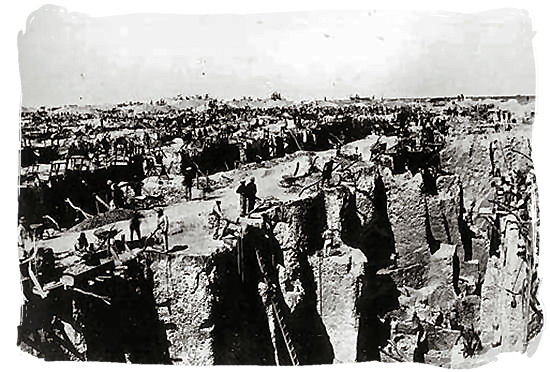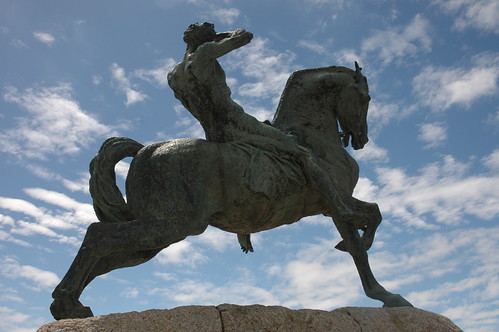The cache is at Rhodes Memorial.

It is a high muggle area, quieter on days with bad weather.
Please use appropriate levels of stealth.
There is a good restaurant in the Herbert Baker cottage behind the memorial.
This cache is to replace a micro cache of the same name. It used to be a two part multi with a regular container at the final. Repeated loss of the first cache has caused me to change it to a multi requiring information rather than finding an initial cache. Pity!
CECIL JOHN RHODES 1853 — 1902
Cecil John Rhodes was born the younger son of a minister of religion in Bishops Stortford, England in 1853. He was a sickly child and at the age of seventeen, in an attempt to improve his asthma, his father sent him out to Africa to the care of his elder brother who was pioneering cotton planting in the Umkomaas Valley in Southern Natal. The venture was not successful, and his brother journeyed to the Northern Cape province to try his hand in the “Kimberly diamond rush”. C. J Rhodes followed in 1870, and began dealing in the hopelessly disorganized uncut stone “digger’s market”.
Realizing the unique monetary potential, he doggedly developed the classic cartel, courageously mastering the cut and thrust of devious dealings. His commercial expertise, attracted the respect of Albert Beit, (immortalized by the bridge on the Rhodesian Border), who provided the initial financial backing which, under C. J Rhodes’ skilled manipulation, brought a degree of stability to the market, benefiting all concerned.
Three years later, now only twenty years old, the young Rhodes went up to Oriel College, Oxford, where he studied classics, graduating in 1881, and whence he returned , years later to found Rhodes House his alma mater.
Coming back to Kimberly, the young Rhodes convinced Rothchild to provide the finance to buy out his former rival, Barney Bonato for ultimate control of the diamond market. De Beers Consolidate Mines were formed on the farm of that name, close to the “big hole”, which was purchased, with mineral rights, for £ 6 000.

In 1887, at the tender age of 34, C. J Rhodes was fast becoming the most powerful mining magnate of all time. He was elected to Parliament as Member for Barclay East, before founding the London Syndicate in the British capital through which were then, (and largely are to this day), channeled the majority of international diamond dealings.
His policy of Colonial Expansionism : “The civilized Englishman has a duty to spread his influence throughout Africa, from the Cape to Cairo, for the benefit of all”, (the map of Africa must be all pink). Queen Victoria signed a Royal Charter for the founding of the omnipotent British South Africa Company. With Rhodes at the helm, most of Mashonaland , soon to be renamed Rhodesia (named after Rhodes), was taken over to exploit the vast mineral resources (principally copper and gold), and to develop the vast agriculture potential, (to which the 1950’s later bore witness).
C. J. R’s political career flourished, and he became the respected Prime Minister of the Cape Colony, until he changed his mind too late to stop Jameson who disgraced in his abortive “Raid”, (to annex the Transvaal), in 1896. Pressured into resignation, Rhodes returned to his Cape Town home at Groote Schuur, and devoted some of his time and money to the development of the fruit industry, including the novelty of canning, in and around Stellenbosch. All this while still serving Parliament and directing De Beers. To this day, Rhodes Fruit Farm in Groot Drakenstien, is still part of the Anglo American Consortium. Several other agricultural and viticultural enterprises owe their existence to Rhodes’ entrepreneurial foresight.
Failing health dogged his daily routine and Rhodes spent increasingly more time at his cottage above the beach of St. James - he hated the “ugly” roof. He had acquired considerable land holdings, including the Groote Schuur Estate and now the Kirstenbosch Gardens, which he later bequeathed to the Botanical Society. He commenced to have avenues of trees planted along the roads to Hout Bay (Camphor Ave.) and Simons Town.
Cecil John Rhodes quietly passed away among the company of a few close friends, in the March of 1902. He was 49 years old.
Rhodes decreed in his will that he was to be buried in Matobo Hills, so when he died in the Cape in 1902 his body came up by train to Bulawayo. His burial was attended by Ndebele chiefs, who asked that the firing party should not discharge their rifles as this would disturb the spirits. Then, for the first and probably the only time, they gave the white man the Matabele royal salute "Bayete".
THE MEMORIAL
The magnificent floodlit memorial to Cecil John Rhodes, stands on the slopes of Devil’s Peak, on the Northern flank of Table Mountain. It was built in 1912 on the very place where Rhodes used to sit and contemplate his future. It was a short ride on horseback from his town home – Groote Schuur – (from which the famous hospital takes it’s name) - which is now separated by the M3 Rhodes Drive motorway.
The Rhodes Memorial was Financed by public subscription raised from the estimated 30 000 citizens of Cape Town in deference for all that Rhodes had accomplished, and the very considerable contribution he had made to the development and increasing prosperity of Southern Africa, (seldom realized these days), during his dynamic 32 years in this Country. Built with granite dressed from the rock bases upon which the Quartzite strata of the mountain rest, the monument was designed by Sir Francis Macey and Sir Herbert Baker who, deprived of Rhodes’ “compulsion to direct”, were able to give full reign to their imagination and skills.
Incorporating Doric columns, the classical architecture so revered by CJR, the eight lions, were cast “in situ” by J.W Swan, modeled upon those protecting Nelson column in Trafalgar Square, London, and are a Tribute to Rhodes’ wish to have real lions roaming his ‘African Wildlife Garden’ for all the citizens to enjoy.

Swan also sculpted the bust of Rhodes, ( whom he, by the way, had never met), from photographs, but sadly nearly finished, his untimely death prevented it’s completion by his own hand.
The dynamic ‘Statue of Energy’, rearing at the foot of the 49 steps, (one for each year of his life), was a tribute to the restless drive and determination of Rhodes, and was presented by G.F. Watts OM. RA> Originally destined for dedication at Victoria Falls, Southern Rhodesia (now Zimbabwe).

There is an identical statue, also in London in Kensington Palace Gardens.
The inscriptions were composed by Rudyard Kipling, a great friend of Rhodes.
THE CACHE
To find the cache figure out the numbers contained in the brackets below:
The cache is hidden at:
S 33° 57. [ The number of times the letter W occurs in the inscription below Rhode's bust ] [ The number of stone Lion heads along the BACK of the monument ] [ There are 4? steps up the monument ]
E18° 27. 5 [ ( The year the memorial was built was 19? ) minus ( the number of stone Lion heads along one side of the monument ) ] [ Rhodes was born in 185? ]